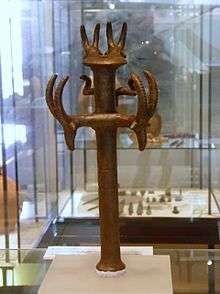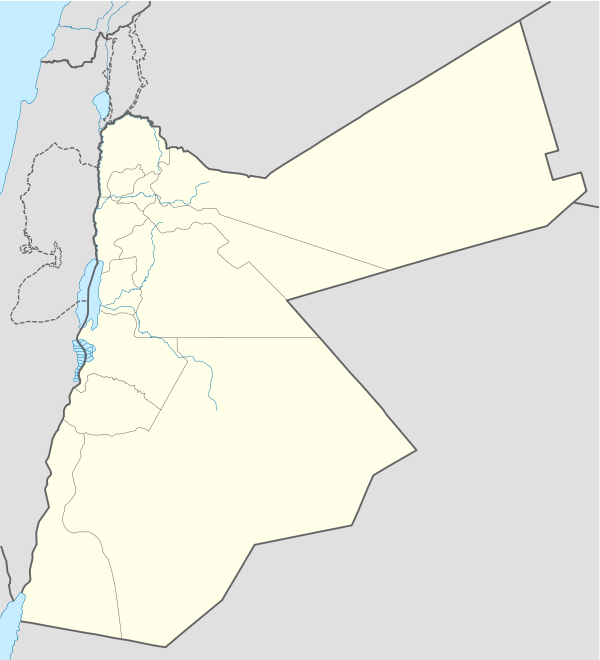Ghassulian
Ghassulian refers to a culture and an archaeological stage dating to the Middle and Late Chalcolithic Period in the Southern Levant (c. 4400 – c. 3500 BC).[1] Its type-site, Teleilat Ghassul (Teleilat el-Ghassul, Tulaylat al-Ghassul), is located in the eastern Jordan Valley near the northern edge of the Dead Sea, in modern Jordan. It was excavated in 1929-1938 and in 1959–1960, by the Jesuits.[2][3][4] Basil Hennessy dug at the site in 1967 and in 1975–1977, and Stephen Bourke in 1994–1999.[1][5]


| Chalcolithic Eneolithic, Aeneolithic, or Copper Age |
|---|
|
↑ Stone Age ↑ Neolithic |
|
West Asia
|
|
Metallurgy, Wheel, Domestication of the horse |
|
↓ Bronze Age ↓ Iron Age |
Part of a series on the |
|---|
| History of Palestine |
-Temple_Mount-Dome_of_the_Rock_(SE_exposure).jpg) |
| Prehistory |
| Ancient history |
| Classical period |
|
| Islamic rule |
| Modern era |
|
|
The Ghassulian stage was characterized by small hamlet settlements of mixed farming peoples, who had immigrated from the north and settled in the southern Levant - today's Jordan, Israel and Palestine.[3] People of the Beersheba Culture (a Ghassulian subculture) lived in underground dwellings - a unique phenomenon in the archaeological history of the region - or in houses that were trapezoid-shaped and built of mud-brick. Those were often built partially underground (on top of collapsed underground dwellings) and were covered with remarkable polychrome wall paintings.[3][6] Their pottery was highly elaborate, including footed bowls and horn-shaped drinking goblets,[3] indicating the cultivation of wine. Several samples display the use of sculptural decoration or of a reserved slip (a clay and water coating partially wiped away while still wet).[3] The Ghassulians were a Chalcolithic culture as they used stone tools but also smelted copper.[3][6] Funerary customs show evidence that they buried their dead in stone dolmens [7] and also practiced secondary burial.[6]
Settlements belonging to the Ghassulian culture have been identified at numerous other sites in what is today southern Israel, especially in the region of Beersheba, where elaborate underground dwellings have been excavated. The Ghassulian culture correlates closely with the Amratian of Egypt and also seems to have affinities (e.g., the distinctive churns, or “bird vases”) with early Minoan culture in Crete.[3][6]
Definition
Ghassulian, a name applied to a Chalcolithic culture of the southern Levant, is derived from the eponymic site of Teleilat (el) Ghassul, northeast of the Dead Sea in the Great Rift Valley. The name has been used as a synonym for Chalcolithic in general and sometimes for late phases, associated with late strata at that site and other sites considered to be contemporary. More recently it has come to be associated with a regional cultural phenomenon (defined by sets of artifacts) in what is today central and southern Israel, the Palestinian territories in the West Bank, and the central area of western Jordan; all either well-watered or semi-arid zones. Other phases of the Chalcolithic, associated with different regions of the Levant, are Qatifian and Timnian (arid zones) and Golanian. The use of the name varies from scholar to scholar.
Origins
The main culture of the Chalcolithic era in Israel is the Ghassulian culture, named after the name of its type-site, Teleilat el-Ghassul, located in the eastern part of the Jordan Rift Valley, opposite Jericho. Afterwards, many additional settlements, located in other archaeological sites, were identified as Ghassulian settlements. All these settlements had been built in areas that had not been previously inhabited, mainly on the outskirts of populated areas. Thus, Chalcolithic settlements have been discovered in the Jordan Rift Valley, in the Israeli coastal plain and on its fringes, in the Judaean Desert and in the northern and western Negev. On the other hand, it seems that people of the Chalcolithic period did not settle in the mountainous regions of Israel or in northern Israel. Several facts allow us to assume that the carriers of this culture were immigrants who had brought their own culture with them: all excavated sites represent an advanced stage of this culture, whereas no evidence of its nascent stages has been discovered, so far, anywhere in the region. This culture's characteristics indicate they had connections with neighboring regions and that their culture had not evolved in the southern Levant. Their origins are not known.[6][8]
It is hard to determine the time of the Ghassulian settlement in the region, and whether or not they had evolved out of local, pre-Ghassulian, populations (such as the Bsorian culture).[9] It could generally be said that most of these settlements date to the 2nd half of the 5th millennium BC, and that they usually existed for only a short period of time, with the exception of Teleilat el-Ghassul, where 8 successive layers of occupation from the Chalcolithic have been excavated, of which 6 are considered Ghassulian and the earlier, pre-Ghassulian, layers are thought to belong to the Besorian culture. The total depth of these layers is 4.5 meters.[6][8]
Ghassulian Copper Industry
The earliest evidence to the existence of a copper-industry in Israel was discovered in Bir abu Matar, Near Be'er Sheba, which specialized in copper production and the casting of copper tools and artifacts. No copper ore is naturally available in the area of Beersheba, so it appears that the ore was brought here from Wadi Feynan, in southern Jordan, and possibly also from Timna, where an ancient copper mine was discovered. It was attributed by Beno Rothenberg to the Chalcolithic era.[6]
Dates and transition phases
The Ghassulian, if used as a synonym for the entire Chalcolithic period and not, as more appropriately, just to the Late Chalcolithic, followed a Late Neolithic period and was succeeded by an Early Bronze I (EB I) period. Little is understood of the transition from the latest Chalcolithic to the earliest EB I, but there was apparently some transition of ceramic, flint-knapping and metallurgical traditions, especially in the southern regions of the southern Levant. The dates for Ghassulian are dependent upon 14C (radiocarbon) determinations, which suggest that the typical later Ghassulian began sometime around the mid-5th millennium and ended ca. 3800 BC. The transition from Late Ghassulian to EB I seems to have been ca. 3800-3500 BC.
The Issue of the nature of the transition from the Late Neolithic to the Early Chalcolithic is re-examined in this article [...] The Late Neolithic assemblages are closely to be identified with earlier Neolithic norms, whereas the Early Chalcolithic assemblages display all the hallmarks of the later Classic Ghassulian culture. -- S.J. Bourke [5]
See also
- Chalcolithic Temple of Ein Gedi
- Nahal Mishmar, where artifacts possibly originating at the Chalcolithic Temple of Ein Gedi were found
- Pre-history of the Southern Levant
- History of pottery in the Southern Levant
- Syro-Palestinian archaeology
- Proto-Semitic homeland
- Beersheba Culture
References
- "The Chronology of the Ghassulian Chalcolithic Period in the Southern Levant: New 14C Determinations from Teleilat Ghassul, Jordan (PDF Download Available)". ResearchGate. Retrieved 2017-10-15.
- Hitti, 2004, p. 26.
- "Ghassulian culture". Encyclopedia Britannica. Retrieved 2017-10-04.
- "Chalcolithic Materials From Teleilat Ghassul in the Semitics Icor Library - University Libraries". libraries.cua.edu. Retrieved 2017-10-10.
- Bourke, S.J. "The Late Neolithic/Early Chalcolithic Transition at Teleilat Ghassul: Context, Chronology and Culture". Paléorient (in French). 33 (1): 15–32. doi:10.3406/paleo.2007.5205.
- Rappel, Joel (1980). History of the Land - Israel, Volume I, edited by Joel Rappel. Israel: The Israeli Ministry of Defense. pp. 47–60. ISBN 978-9650500504.
- A. Gorzalczany, "Centre and Periphery in Ancient Israel: New Approximations to Chalcolithic Funerary Practices in the Coastal Plain", Antiguo Oriente 5 (2007): 205-230.
- "Palestine | History, People, & Religion". Encyclopedia Britannica. Retrieved 2017-10-05.
- "Israel Antiquities Authority". www.antiquities.org.il (in Hebrew). Retrieved 2017-10-23.
Bibliography
- Bourke, S. J. (1997): The “Pre-Ghassulian” Sequence at Teleilat Ghassul: Sydney University Excavations 1975–1995. pp. 395–417 in H. G. K. Gebel, Z. Kafafi and G. O. Rollefson, eds. The Prehistory of Jordan, II: Perspectives from 1997 (Studies in Early Near Eastern Production, Subsistence, and Environment 4). Berlin: Ex Oriente.
- Bourke, S. Zoppi, U., Meadows, J., Hua, Q., and Gibbins, S. (2004): The end of the Chalcolithic Period in the south Jordan Valley: New 14C Determinations from Teleilat Ghassul, Jordan. Radiocarbon 46/1: 315–323.
- Epstein, C. (1998): The Chalcolithic Culture of the Golan. Jerusalem: The Israel Antiquities Authority (IAA Reports 4).
- Gilead, I. (1988): The Chalcolithic Period in the Levant. Journal of World Prehistory 2:397-443.
- 1994 The History of the Chalcolithic Settlement in the Nahal Beer Sheva Area: The Radiocarbon Aspect. Bulletin of the American Schools of Oriental Research 296: 1-14.
- 2011 Chapter 2: Chalcolithic Culture History: Ghassulian and Other Entities in the Southern Levant. pp. 12–24 in (eds.) J. L. Lovell and Y. M. Rowan. Culture, Chronology and the Chalcolithic: Theory and Transition (CBRL Levant Supplementary monograph series Vol. 9). Oxford and Oakville: Oxbow Books.
- Joffe, A. H. and Dessel, J. P. (1995): Redefining Chronology and Terminology for the Chalcolithic of the Southern Levant. Current Anthropology 36: 507–518.
- Klimscha, F. (2009): Radiocarbon Dates from Prehistoric cAqaba and Other Related sites from the Chalcolithic Period. pp. 363–419 in eds. Khalil, Prehistoric ‘Aqaba I (Orient-Archäologie Band 23). Verlag Marie Leidorf GmbH: Rahden, Westfalia, German Democratic Republic.
- Levy, T. E. (1986): The Chalcolithic Period. Biblical Archaeologist 49: 82-108.
- Lovell, J. L. (2001): The Late Neolithic and Chalcolithic Periods in the Southern Levant. New Data from the Site of Teleilat Ghassul, Jordan (Monographs of the Sydney University Teleilat Ghassul Project 1; BAR International Series 974). Oxford: British Archaeological Reports.
- Hitti, Philip Khuri (2004), History of Syria including Lebanon and Palestine, Gorgias Press LLC, ISBN 978-1-59333-119-1
- History of the Land - Israel, Volume I, edited by Joel Rappel, 1980, ISBN 978-9650500504. pp 47–60 in the Hebrew 1980 edition: The Land Of Israel in the Chalcolithic Era, by David Ussishkin.
External links
- Paul James Cowie, Archaeowiki: Teleilat Ghassul
- Andie Byrnes, The Chalcolithic
- Paul James Cowie, Archaeowiki: Chalcolithic of the Southern Levant